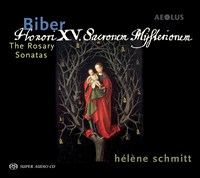Texte paru dans: / Appeared in: |
|
|
Outil de traduction (Très approximatif) |
|
|
Reviewer:
Fabrice Fitch
Schmitt’s reflections on
performing the cycle are evocative and informative (and it’s worth adding that
the accompanying essay by the noted scholar Peter Wollny is equally intriguing,
proposing among other things a later date for the set’s compilation than has
generally been accepted). That said, the tempi chosen throughout are far slower
than the norm, in fact slower than any previous recording as far as I can te ll.
In the concluding Passacaglia this is not so noticeable, but elsewhere Schmitt
will linger or pause on individual moments, which further obstructs the flow of
the narrative or the individual line. All of this certainly presents the cycle
in a different light, though other more concrete details are frankly
disconcerting: the articulation of the Gigue for ‘The Crowning of Jesus with
Thorns’ does little to suggest mockery or sarcasm; the metronomic approach to
the variation of the set’s very last Sarabande has none of the graceful
saltando familiar from other interpretations; and, in the principal section
of the sonata for ‘The Resurrection’, several bizarre editorial decisions
misquote the tune being quoted in the violin part, nullify its imitation with
the bass and result in consecutives into the bargain. From an artist of this
experience it’s very surprising. Above all, one misses the casual overcoming of
difficulty, the sprezzatura that is the hallmark of so much instrumental
music of this period, and with which Biber must surely have captivated his
audiences. |
|




